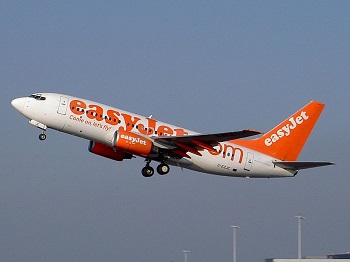New uniforms for crew have now been debuted by the U.K. airline, which are lit with LED.
New uniforms have now been released for EasyJet crewmembers to wear, which are embedded with wearable technology in the form of sensors and LED lights that are designed to offer several features and benefits.
The cabin crew now have high tech uniforms that include many features of embedded wearables.
The airline was first founded in 1995 by Sir Stelios Haji-Ioannou and is the largest airline in the United Kingdom, based on the number of passengers it carries. It is now using the company’s 20th anniversary as the opportunity for cabin crew and engineers to be able to don uniforms that have wearable technology features woven into them. Both of these types of uniforms have features such as microphones built into them. The microphones were chosen to make it possible for pilots, crew and engineers to communicate with each other.
Cabin crew uniforms also feature dots of LEDs along their shoulders among their wearable technology features.
 The LEDs indicate the flight number and the destination of the plane. The lights provide illumination along the hemlines and also offer additional lighting for visibility in case of an emergency.
The LEDs indicate the flight number and the destination of the plane. The lights provide illumination along the hemlines and also offer additional lighting for visibility in case of an emergency.
On the other hand, the wearables laden uniform meant for engineers has both LEDS and reflective panels in the hood. The idea is that the clothing itself will provide lighting to a work area so the engineers won’t be required to have to try to direct a light while trying to complete their tasks at the same time. This will leave both hands free to complete a job, replace panels, and do everything else that is required to keep aircraft in top shape.
Furthermore, built-in video cameras make it possible to send images to other engineers in order to receive a second opinion about complex problems and the best course to take in order to correct them. At the same time, barometers and air quality sensors are meant to help engineers keep up with the safety of their work environments. It even becomes possible to use this wearable technology to create air quality maps for various cities.
Passengers flying Alaska Airlines will now be able to use these new services at the L.A. International Airport
Travelers are already using mobile commerce based kiosks to be able to check in through certain airlines at the Los Angeles International Airport, but these services are about to start expanding quite significantly over the next three years, starting with Alaska Airlines.
Both airports and airlines are expected to begin making considerable investments into m-commerce.
A new survey has shown that mobile commerce kiosks are expected to take off at many different airports and through a range of airlines. In fact, the survey showed that almost 90 percent of airports intend to make an investment into this type of mobile technology within the upcoming three years. This will be good news for tech savvy travelers who are rapidly growing in numbers.
These kiosks use mobile commerce technology to allow a passenger to check in using a smartphone.
 Using this mobile technology, some of the largest airports in the world are giving travelers a way to obtain a boarding pass without having to check in with a gate agent. A recent survey conducted by SITA, a multinational technology firm, has shown that these kiosks are currently serving about 2.4 billion passengers every year. According to the chief exec at SITA, Francesco Violante, “This is the age of the connected traveler with nearly all passengers carrying mobiles, tablets and other devices.”
Using this mobile technology, some of the largest airports in the world are giving travelers a way to obtain a boarding pass without having to check in with a gate agent. A recent survey conducted by SITA, a multinational technology firm, has shown that these kiosks are currently serving about 2.4 billion passengers every year. According to the chief exec at SITA, Francesco Violante, “This is the age of the connected traveler with nearly all passengers carrying mobiles, tablets and other devices.”
Some additional key findings from this survey have shown the following:
• Almost 90 percent of airport operators that participated in the study said that they had intentions to invest in kiosks, as well as self-boarding stations and self-serve bag dropping stations within the span of the next three years. This year, alone, airports are expecting to spend about $6.8 billion on tech.
• Nearly half of the airlines that participated in the survey are able to update passengers about flight issues – such as cancellations or delays – via mobile device. By 2017, that figure is expected to rise to 97 percent.
• Under 5 percent of passengers around the globe are currently using their mobile commerce to check in, but that rate is expected to reach the 15 percent mark by 2017.
 The LEDs indicate the flight number and the destination of the plane. The lights provide illumination along the hemlines and also offer additional lighting for visibility in case of an emergency.
The LEDs indicate the flight number and the destination of the plane. The lights provide illumination along the hemlines and also offer additional lighting for visibility in case of an emergency.
 Using this mobile
Using this mobile 